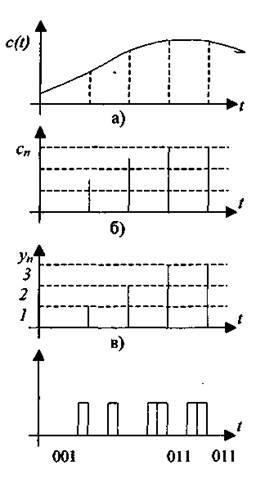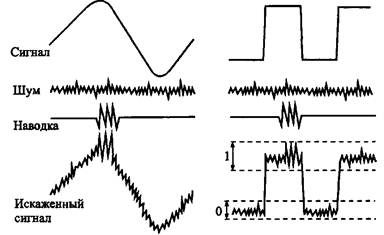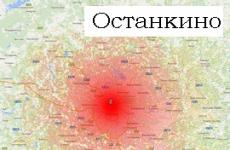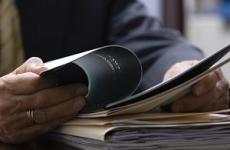Formal, technical, natural, social, humanitarian, and other sciences. What is the measurement signal different from the signal? Give examples of measuring signals used in various sections of science and technology.
The concept of the interface of digital PBX
CSK should provide an interface (interface) with analog and digital subscriber lines (AL) and transmission systems.
By the jointcalled the boundary between two functional blocks, which is determined by the functional characteristics, the general characteristics of the physical connection, the characteristics of the signals and other characteristics depending on the specifics.
The junction provides one-time determination of the parameters of the connection between two devices. These parameters relate to the type, number and function of the connecting circuits, as well as to the type, form and sequence of signals that are transmitted through these circuits.
The exact definition of types, quantities, shapes and sequences of compounds and the relationship between the two functional blocks at the junction between them is set joint specification.
The interfaces of a digital PBX can be divided into the following.
Analog subscriber interface;
Digital subscriber interface;
ISDN Subscriber Interface;
Network (digital and analog) joints.
Ring Connectors
Ring structures are used in a wide range of communication areas. First of all, these are ring transmission systems with temporal grouping, which essentially have the configuration of serially connected unidirectional lines forming a closed circuit or ring. At the same time in each node of the network two main functions are implemented:
1) each node works as a regenerator to restore the incoming digital signal and transmit it again;
at the nodes of the network, the structure of the time multiplexing cycle is recognized and ring communication is performed by
2) the removal and input of a digital signal in certain channel intervals assigned to each node.
The possibility of redistributing channel intervals between arbitrary pairs of nodes in a ring system with temporary multiplexing means that the ring is a distributed transmission and switching system. The idea of simultaneous transmission and switching in ring structures was extended to digital switching fields.
In such a scheme, a duplex connection can be established using a single channel between any two nodes. In this sense, the ring scheme performs space-time transformation of the coordinates of the signal and can be considered as one of the options for constructing the S / T-stage.
Analog, discrete, digital signals
In telecommunication systems, information is transmitted via signals. The International Telecommunication Union gives the following definition signal:
The signal of telecommunication systems is a set of electromagnetic waves, which propagates through a one-way transmission channel and is intended to act on the receiving device.
1) analog signal- a signal in which each representing parameter is given by a continuous time function with a continuous set of possible values
2) discrete signal level -a signal for which the values of the representing parameters are given by a continuous time function with a finite set of possible values. The process of sampling the signal level is called quantization;
3) time discrete signal -a signal for which each representative parameter is given by a discrete time function with a continuous set of possible values
4) digital signal -a signal whose values of the parameters are given by a discrete time function with a finite set of possible values
Modulation- this is the conversion of one signal to another by changing the parameters of the signal carrier in accordance with the converted signal. Harmonic signals, periodic sequences of pulses, etc. are used as a carrier signal.
For example, when transmitting a digital signal along a binary signal line, a constant component of the signal may appear due to the predominance of ones in all code words.
The absence of a constant component in the line allows the use of matching transformers in linear devices, as well as provide remote power supply of regenerators with direct current. To get rid of the undesirable constant component of the digital signal, before sending the binary signals to the line, they are converted using special codes. For the primary digital transmission system (DSP) code HDB3 is adopted.
The coding of a binary signal into a modified quasi-troar signal using the HDB3 code is performed according to the following rules (Fig. 1.5).

Fig. 1.5. Binary and corresponding HDB3 codes
Pulse code modulation
The conversion of a continuous primary analog signal to a digital code is called pulse code modulation(PCM). The main operations in PCM are time discretization, quantization (discretization by discrete time signal level) and encoding operations.
Analog discretization over timeis called a transformation, in which the representative parameter of an analog signal is given by a set of its values at discrete points in time, or, in other words, in which from a continuous analog signal c (t)(Fig. 1.6, a) receive sample values with"(Fig. 1.6, b). The values of the representative parameter of the signal, obtained as a result of the time discretization operation, are called counts.
The most widespread are digital transmission systems in which uniform sampling of an analog signal is applied (samples of this signal are made at equal time intervals). With uniform sampling, the following concepts are used: sampling interval At(time interval between two adjacent samples of a discrete signal) and fd sampling rate(the reciprocal of the sampling interval). The size of the sampling interval is selected in accordance with the Kotelnikov theorem.
According to the Kotelnikov theorem, an analog signal with a limited spectrum and an infinite observation interval can be reconstructed without errors from a discrete signal obtained by sampling the original analog signal if the sampling frequency is twice the maximum frequency of the analog signal spectrum:

Kotelnikov theorem
Kotelnikov's theorem (in the English-language literature, the Nyquist-Shannon theorem) states that if an analog signal x (t) has a limited spectrum, it can be restored uniquely and without loss in its discrete counts, taken at a frequency of more than twice the maximum frequency of the spectrum, Fmax .
Basic principles of digital electronics.
Introduction
DIGITAL DEVICES
Lecture notes
Digital electronics are now increasingly replacing the traditional analog. Leading companies producing very different electronic equipment, more and more often declare a full transition to digital technology.
Advances in the production technology of electronic circuits ensured the rapid development of digital technology and devices. The use of digital methods of processing and transmitting signals can significantly improve the quality of communication lines. Digital methods of processing and switching signals in telephony allow several times to reduce the weight and size characteristics of switching devices, to increase the reliability of communication, to introduce additional functionality. The emergence of high-speed microprocessors, high-capacity RAM microcircuits, small-sized storage devices for large-capacity hard drives made it possible to create fairly inexpensive universal personal electronic computers (computers) that have found very wide application in everyday life and production. Digital technology is indispensable in remote signaling and telecontrol systems used in automated production, management of remote objects, such as spacecraft, gas pumping stations, etc. Digital technology has also taken a strong place in electrical radio measuring systems. Modern devices for recording and reproducing signals are also unthinkable without the use of digital devices. Digital devices are widely used to control household appliances.
It is very likely that in the future digital devices will dominate the electronics market.
To begin with, we will give a few basic definitions.
Signal- this is any physical quantity (for example, temperature, air pressure, light intensity, current intensity, etc.) that changes with time. Thanks to this change in time, the signal can carry some information.
Electric signal- is an electrical quantity (for example, voltage, current, power), changing with time. All electronics mainly work with electrical signals, although recently more and more light signals are used, which represent the time-varying intensity of light.
Analog signal- this is a signal that can take any value within certain limits (for example, the voltage can vary smoothly from zero to ten volts). Devices that work only with analog signals are called analog devices.
Digital signal- this is a signal that can take only two values (sometimes three values). Moreover, some deviations from these values are allowed (Fig. 1.1). For example, the voltage can take two values: from 0 to 0.5 V (zero level) or from 2.5 to 5 V (level one). Devices that work exclusively with digital signals are called digital devices.
In nature, almost all signals are analog, that is, they vary continuously in some limits. That is why the first electronic devices were analog. They converted physical quantities into proportional voltage or current, performed some operations on them, and then did inverse transformations into physical quantities. For example, a person’s voice (air vibrations) is converted into electrical oscillations using a microphone, then these electrical signals are amplified by an electronic amplifier and converted into vibrations of air, into a louder sound, using a speaker system.
Fig. 1.1. Electrical signals: analog (left) and digital (right).
All operations performed by electronic devices on signals can be divided into three large groups:
Processing (or conversion);
Broadcast;
Storage.
In all these cases, the useful signals are distorted by spurious signals - noise, interference, and pickups. In addition, when processing signals (for example, when amplifying, filtering), their shape is also distorted due to the imperfection, imperfection of electronic devices. And when transmitting over long distances and during storage, the signals are also attenuated.

Fig. 1.2. The distortion of noise and interference from the analog signal (left) and the digital signal (right).
In the case of analog signals, all this significantly impairs the useful signal, since all its values are allowed (Fig. 1.2). Therefore, each transformation, each intermediate storage, each transmission over a cable or on the air degrades the analog signal, sometimes up to its complete destruction. It is also necessary to take into account that all noise, interference and interference are fundamentally not amenable to exact calculation, therefore it is absolutely impossible to accurately describe the behavior of any analog devices. In addition, over time, the parameters of all analog devices change due to the aging of elements, so the characteristics of these devices do not remain constant.
Unlike analog, digital signals that have only two allowed values are protected from noise, interference and interference much better. Small deviations from the allowed values do not distort the digital signal, as there are always zones of tolerances (Fig. 1.2). That is why digital signals allow much more complex and multi-stage processing, much longer lossless storage and much better transmission than analog ones. In addition, the behavior of digital devices can always be accurately calculated and predicted. Digital devices are much less susceptible to aging, since a small change in their parameters does not affect their functioning. In addition, digital devices are easier to design and debug. It is clear that all these advantages ensure the rapid development of digital electronics.
However, digital signals have a major disadvantage. The fact is that at each of its allowed levels the digital signal must remain at least for some minimum time interval, otherwise it will be impossible to recognize. And the analog signal can take any of its value for an infinitely small time. It can be said otherwise: the analog signal is defined in continuous time (that is, at any time), and digital - in discrete time (that is, only at selected points in time). Therefore, the maximum achievable performance of analog devices is always fundamentally more than digital devices. Analog devices can work with more rapidly changing signals than digital ones. The speed of processing and transmitting information by an analog device can always be made higher than the speed of its processing and transfer by a digital device.
In addition, a digital signal transmits information only in two levels and a change in one of its levels to another, and an analog signal transmits information also with each current value of its level, that is, it is more capacious in terms of information transfer. Therefore, to transfer the amount of useful information that is contained in a single analog signal, it is often necessary to use several digital signals.
(usually from 4 to 16).
In addition, as already noted, in nature, all signals are analog, that is, to convert them into digital signals and for the inverse transformation requires the use of special equipment (analog-digital and
digital-to-analog converters). So nothing is given for nothing, and the price for the advantages of digital devices can sometimes be unacceptably large.
The purpose of radio-electronic devices, as is known, is the receipt, transformation, transmission and storage of information represented in the form of electrical signals. Signals acting in electronic devices and, accordingly, the devices themselves are divided into two large groups: analog and digital.
Analog signal - a signal that is continuous in level and in time, i.e. such a signal exists at any moment in time and can assume any level from a given range.
Quantized signal - a signal that can take only certain quantized values corresponding to quantization levels. The distance between two adjacent levels is the quantization step.
Discretized signal - a signal whose values are given only at times, called sampling times. The distance between adjacent sampling times is the sampling step. With constant, the Kotelnikov theorem is applicable: ![]() where is the upper limiting frequency of the signal spectrum.
where is the upper limiting frequency of the signal spectrum.
Digital signal - signal, quantized by level and sampled in time. Quantized values of a digital signal are usually encoded with a certain code, with each sample selected during the sampling process being replaced by a corresponding codeword, the symbols of which have two values — 0 and 1 (Fig. 2.1).
Typical representatives of analog electronics devices are communication, broadcasting and television devices. The general requirements for analog devices are minimal distortion. The desire to meet these requirements leads to the complexity of electrical circuits and device design. Another problem of analog electronics is the achievement of the required noise immunity, because in an analog communication channel, noise is fundamentally irremovable.
Digital signals are generated by electronic circuits, in which the transistors are either closed (the current is close to zero) or completely open (the voltage is close to zero), therefore, a small amount of power is dissipated on them and the reliability of digital devices is higher than analog ones.
Digital devices are more noise-proof than analog ones, since small extraneous disturbances do not cause erroneous operation of devices. Errors appear only under such disturbances in which a low signal level is perceived as high, or vice versa. In digital devices, you can also apply special codes to correct errors. In analog devices, this is not possible.
Digital devices are insensitive to the spread (within acceptable limits) of the parameters and characteristics of transistors and other circuit elements. Error-free digital devices do not need to be tuned, and their characteristics are completely repeatable. All this is very important in the mass production of devices using integrated technology. The cost-effectiveness of the production and operation of digital integrated circuits has led to the fact that in modern radio-electronic devices not only digital, but also digital analog signals. Digital filters, regulators, multipliers, etc. are common. Before digital processing, analog signals are converted to digital using analog-to-digital converters (ADC). The inverse transformation — the restoration of analog signals by digital signals — is performed using digital-to-analog converters (D / A converters).
With all the variety of problems solved by digital electronics devices, they function in number systems that operate with only two digits: zero (0) and one (1).
The operation of digital devices is usually clockedsufficiently high-frequency clock pulse generator. During one cycle, the simplest micro-operation is realized — reading, shifting, logical command, etc. The information is represented as a digital word. Two ways are used to transmit words - parallel and serial. Sequential coding is used when exchanging information between digital devices (for example, in computer networks, modem communications). Information processing in digital devices is implemented using parallel coding of information that provides maximum performance.
The element base for the construction of digital devices are integrated circuits (IC), each of which is implemented using a certain number of logic elements - the simplest digital devices that perform elementary logic operations.
In order for the message to be transmitted from the source to the recipient, some material substance is necessary - the information carrier. A message transmitted via media is called a signal. In general, a signal is a time-varying physical process. Such a process may contain various characteristics (for example, when transmitting electrical signals, the voltage and current intensity may vary).
Signal parameters are called its characteristics, which are used to represent messages. In the case when the signal parameter takes a finite number of values that are sequential in time (all of them can be numbered), the signal is called discrete, and the message transmitted with the help of such signals is called a discrete message. Information transmitted by the source in this case is also called discrete. If the source generates a continuous (analog) message (respectively, the signal parameter is a continuous function of time), the signal is called continuous (analog), and the message transmitted using such signals is an analog message.
An example of a discrete message is the process of reading a book, the information in which is represented by text, i.e. discrete sequence of individual icons (letters). An example of a continuous message is human speech transmitted by a modulated sound wave; The signal parameter in this case is the pressure created by this wave at the point where the receiver, the human ear, is located.
A typical example of an analog signal is the voltage output from a microphone when talking in front of it, singing, or playing musical instruments. The air pressure during the sound of the source varies in a small range relative to normal atmospheric. The membrane of the microphone, bending under the action of sound pressure, creates some voltage at the terminals of the voice coil of the microphone. This voltage is directly proportional to sound pressure, i.e. changes in the same way as the name “analog signal”.
ANALOG SIGNAL.
Analog signals are used in telephone communications, broadcasting and television. It is technically easier, and the history of radio engineering has developed so that the first began to use analog signals. This in no way relates to the telegraph, where the figure has always dominated.
In normal conversation, the power of the loud sounds of a human voice is 10,000 times greater than the intensity of faint sounds.
If there is noise (in the subway train, at the airport), weak sounds should not be masked by noise so that they can also be disassembled. That is why you have to strain your voice in the subway, shouting in your ear to your interlocutor at the airport, when a jet airliner roars with engines.
When transmitting analog signals, a much larger signal-to-noise ratio is required than when transmitting binary digital signals.
A big disadvantage of analog signals is that analog signals cannot be regenerated, since their shape is not known in advance (there is no need to transmit a known signal!).
When using an analog signal in a long-distance telephone line, the quality of communication was often poor. This is explained by the fact that a weak speech signal during transmission over a wire telephone line must be periodically amplified every 100–200 km. The wires are buzzing, the amplifiers are noisy, and each of these sources of interference distorts the transmitted signal more and more.
Due to the advantages of binary signals over analog signals, currently binary channels are widely used to transmit analog speech signals. The introduction of such systems on long-distance communication lines significantly improved the quality of communication.
6.2. MEASURING RELATIONSHIP SIGNAL - NOISE.
The ratio of the highest instantaneous signal power P max to the smallest P min (dynamic range of the signal D s) is usually measured in decibels.
Bel is the difference in power levels, the ratio of which is 10 and, accordingly, the decimal logarithm of this ratio is 1.
Decibel is the decimal part of Bela.
(dB) level difference in decibels is ten decimal logarithms of the power ratio.
Since = - the average signal power is equal to the square of the amplitude of the signal and = - the average noise power is equal to the square of the noise amplitude, then
(dB) the level difference in decibels is the twenty decimal logarithm of the voltage ratio.
For good voice quality, transmitted by telephone, it is necessary to provide a signal-to-noise ratio of about 10,000 or 40 decibels (dB): (dB). In other words, it is necessary to provide a signal-to-noise ratio of approximately 100: (dB)
Experienced radio operators can parse speech at a signal-to-noise ratio of about ten, but on condition that the transmitted text is familiar and familiar.
End of work -
This topic belongs to:
Instrumentation and Informatics
INSTRUMENT MAKING AND INFORMATICS ... Department of Information Systems for Robotic and Mechatronic ...
If you need additional material on this topic, or you did not find what you were looking for, we recommend using the search in our database:
What we will do with the resulting material:
If this material was useful for you, you can save it to your page on social networks:
| Tweet |
All topics in this section:
Formula Hartley.
If the number of system states is equal to N, then this is equivalent to the information given by I answers like “YES-NO” to questions posed in such a way that “YES” and “NO” are equally likely. N = 2I
ENTROPY IN INFORMATICS AND PHYSICS.
Both in the physical and in the informational sense, the magnitude of the entropy characterizes the degree of diversity of the system states. Shannon's formula coincides with the Boltzmann formula for the entropy of physical
PROBABLE AND VOLUME APPROACHES TO MEASURING THE AMOUNT OF INFORMATION.
To define the concept of "amount of information" is quite difficult. There are two main approaches to solving this problem. Historically, they arose almost simultaneously. In the late 40s of the XX century, one of
DIFFERENT ASPECTS OF INFORMATION ANALYSIS.
No matter how important the measurement of information is, it does not reduce all the problems associated with this concept. When analyzing information, its properties such as truth can come to the fore
LETTER (SIGN, SYMBOL). ALPHABET.
Information is transmitted in the form of messages. Discrete information is written using some finite set of characters, which we will call letters, without putting in this word the usual constraints
CODE AND DECODER.
In a communication channel, a message composed of letters (signs, symbols) of one alphabet can be converted into a message from letters of another alphabet. The code is a rule that describes an unambiguous
INTERNATIONAL BYTIC CODING SYSTEMS.
Computer science and its applications are international. This is due both to the objective needs of mankind in uniform rules and laws for the storage, transmission and processing of information, and to the fact that
NOISE-RESISTANT INFORMATION CODING.
The theory of noise-resistant coding is rather complicated, and our reasoning is very simplified. The main condition for detecting and correcting errors in the received code combos
TRANSFER OF INFORMATION.
The theoretical basis of information transfer is the Theory of signals and information transfer. The theory of signals and information transfer examines the processes of formation, accumulation, collection, measurement, processing
FROM THE HISTORY OF DEVELOPMENT OF INFORMATION TRANSFER.
Problems of communication organization go back centuries. The very being of man required communication and exchange of information. The prototype of the communication lines was an alarm using fires, the use of optical
THEOREM KOTELNIKOV.
The Kotelnikov theorem is also called the reading theorem or sampling theorem. Sampling is the signal amplitude count in
INFORMATION CAPACITY DISCRETE SIGNAL (MESSAGES). SHANNON FORMULA.
The level of noise (interference) does not allow to accurately determine the amplitude of the signal and in this sense introduces some uncertainty in the value of the signal samples. If there was no noise, then the number is discrete
BINARY SIGNAL REGENERATION.
Binary-coded signals are convenient in many ways. Like any digital discrete signals, they can be regenerated, i.e. restore, recreate their shape, distorted interference. Kos
IMMUNITY OF BINARY SIGNALS.
The big advantage of binary digital signals is that they require a minimum signal-to-noise ratio in the communication channel, i.e. are the most noise free. Clarify that this is t
BODY SIGNAL CODING.
Any signal is transmitted either by energy or substance. This is either an acoustic wave (sound), or electromagnetic radiation (light, radio waves), or a sheet of paper (written text), or stone radiation.
DISCRETIZATION AND CODING ANALOG SIGNAL.
A continuous message can be represented by a continuous function defined on a certain interval [a, b]. Continuous message can be converted to discrete (this procedure is called discrete
DIGITAL TELEPHONE COMMUNICATION.
Here's how the telephone communication process at the dawn of digital telephone systems was described by the author of the book “Dedication to Radio Electronics” VT. Polyakov. “A few years ago I had a chance to go
DIGITAL TELEGRAPHIC COMMUNICATION.
Let us estimate what the flow of information will be if we replace the telephone conversation with a telegraph transmission of the same text. With an average rate of speech, a person utters 1 - 1.5 words per second. Every word consists
DIGITAL TELEVISION.
The difficulties of presenting television images in digital form are obvious. Let each element have one sample of the signal that needs to be converted into the corresponding code combination.
PARAMETERS OF RADIO SIGNALS.
Information is a collection of information about events, phenomena, objects - in a word, about everything that exists and is happening in the world. The information is presented in the form of a written text, encrypted digitally.
MULTI-CHANNEL COMMUNICATION LINES. SEAL INFORMATION.
MULTICHANNEL TELEPHONE LINES. The Unified Automated Communication Network (EASC) is developing and improving in our country. It is based on cable and radio relay communication lines,
FROM THE HISTORY OF CABLE COMMUNICATION.
In 1876, Alexander Bell received a patent for the invention of "The Telegraph, through which you can transmit human speech." The phone was greeted around the world with great enthusiasm and through
THE PRINCIPLE OF THE OPTICAL FIBER COMMUNICATION.
Thanks to the huge bandwidth optical cable increasingly used in information and computing television networkswhere you need to transfer large amounts of information with exclude
HARDWARE.
Local Area Networks (LAN) unite a relatively small number of computers (usually from 10 to 100, although occasionally there are also large ones) within the same room (educational computer class), buildings or
CONFIGURATION OF LOCAL NETWORKS.
In the simplest networks with a small number of computers, they can be completely equal; the network in this case provides data transfer from any computer to any other for collective work.
ORGANIZATION OF EXCHANGE OF INFORMATION.
In any physical configuration, support for access from one computer to another is performed by the program — a network operating system that, in relation to the operating systems (OS) of individual
GENERAL SPECIFICATION OF SATELLITE COMMUNICATIONS.
The idea of using outer space has long troubled the best minds of mankind. Until they could put an aircraft with a reflector on board into Earth orbit, space communications remained
PRINCIPLES OF SATELLITE COMMUNICATIONS.
Consider some of the most important principles used in satellite systemsintended to transmit information. Let's stop first on the repeater information. Satellite feature
NON-POSITIONAL SYSTEMS OF CALCULATION.
In a nonpositional system, the value of each character in a number does not depend on the position occupied by the character in the number record (there may be a dependence on the place of the character in relation to another character.). Naibo
POSITIONING SYSTEM CALCULATIONS.
In a positional system, the value of each character in a number depends on the position that the character occupies in the number record. The basis of the number system is called the number of different
TRANSFER NUMBERS FROM THE DECIMAL SYSTEM TO ANOTHER SYSTEM.
Ø The full and fractional parts are translated separately. Ø To transfer the integer part of the number from the decimal system to the system with base B, it is necessary to divide it into B. О
TRANSFER NUMBERS INTO DECIMAL SYSTEMS FROM OTHER SYSTEMS.
TRANSFER OF FULL NUMBERS INTO DECIMAL SYSTEM. 23510 = 2 * 102 + 3 * 101 + 5 * 100; 011012 = 0 * 24 + 1 * 23 + 1 * 22 + 0 *
MUTUAL TRANSFORMATIONS OF BINARY, EIGHT-SIXTH AND SIXTEEN NUMBERS.
From a practical point of view, the procedure of mutual transformation of binary, octal and hexadecimal numbers is of interest. To convert a whole binary number to octal neo
PROGRAMMING LANGUAGES. GENERAL CHARACTERISTICS.
Programming languages are artificial languages specially created for human communication with computers. Programming languages are marking systems designed to precisely
LANGUAGE PROGRAMMING SI. HISTORY OF CREATION. GENERAL CHARACTERISTICS.
C programming language (C) was developed by Dennis Ritchie (Dennis Ritchie) in 1972 as a tool for writing the operating system (OS) UNIX for an electronic computer (computer) PDP-11 fi
LANGUAGE PROGRAMMING SI. THE PROCESS OF CREATING AN EXECUTABLE FILE.
· The source file (text of the program in the C programming language) is created in the editor of the programming system, for example Borland C ++. · Extended source file
LANGUAGE PROGRAMMING SI. BASIC TERMS.
Identifiers are the names of variables, constants, functions, labels, etc. External identifiers (names of functions and global variables involved in the build process) according to AN
Basic data types;
· Char-character; · Int - integers; · Float - with a floating point; · Double - with a floating point of double length; · Void - empty with no value. Type of
String constants.
String constants are defined as a sequence of characters enclosed in double quotes: "String constant". NOTE: See 4. LINE AND LINE CONSTANTS. To
Initializers
Initializers are used to assign initial values to variables when they are defined. Initializers have the form: = value; = (list of values); / * complex knowledge
LANGUAGE PROGRAMMING SI. STRUCTURE OF A SIMPLE PROGRAM.
/ * PROGRAM: information.c - an example of a message output. / * 1 * / * / / * * * / / * 2 * / / * ============================= inclu
Signal information - physical process having for man or technical device informationalvalue. It can be continuous (analog) or discrete.
The term “signal” is often identified with the concepts of “data” (data) and “information” (information). Indeed, these concepts are interrelated and do not exist one without the other, but belong to different categories.
Signalis an informational function that carries a message about the physical properties, state or behavior of any physical system, object or environment, and the purpose of signal processing can be considered to extract certain information that is displayed in these signals (briefly, useful or target information) and transformation this information in a form that is convenient for perception and further use.
Information is transmitted in the form of signals. A signal is a physical process that carries information. The signal can be audible, light, in the form of mailing, etc.
The signal is a tangible carrier of information that is transmitted from the source to the consumer. It can be discrete and continuous (analog)
Analog signal- data signal, in which each of the representing parameters is described by a function of time and a continuous set of possible values.
Analog signals are described by continuous functions of time, so an analog signal is sometimes called a continuous signal. Discrete signals (quantized, digital) are opposed to analog signals.
Examples of continuous spaces and corresponding physical quantities: (direct: electrical voltage; circumference: rotor, wheel, gear, analog clock hands, or carrier phase; segment: piston position, control lever, liquid thermometer, or electrical signal limited in amplitude multidimensional spaces: color, quadrature modulated signal.)
The properties of analog signals are largely the opposite of quantized or digital propertiessignals.
The absence of discrete signal levels that are clearly distinguishable from each other makes it impossible to apply the concept of information to its description as it is understood in digital technologies. The “amount of information” contained in one sample will be limited only by the dynamic range of the measuring instrument.
Lack of redundancy. From the continuity of the space of values, it follows that any interference introduced into the signal is indistinguishable from the signal itself and, therefore, the original amplitude cannot be restored. In fact, filtering is possible, for example, by frequency methods, if any additional information is known about the properties of this signal (in particular, the frequency band).
Application:
Analog signals are often used to represent continuously changing physical quantities. For example, an analog electrical signal taken from a thermocouple carries information about temperature changes, a microphone signal about fast pressure changes in a sound wave, and so on.
Discrete signalis composed of a countable set (that is, such a set, whose elements can be recalculated) of elements (they say - information elements). For example, the “brick” signal is discrete. It consists of the following two elements (this is the syntactic characteristic of this signal): the red circle and the white rectangle inside the circle, located horizontally in the center. It is in the form of a discrete signal that the information that the reader is now mastering is presented. The following elements can be distinguished: sections (for example, “Information”), subsections (for example, “Properties”), paragraphs, sentences, separate phrases, words and individual signs (letters, numbers, punctuation marks, etc.). This example shows that, depending on the pragmatics of the signal, you can select different information elements. In fact, for a person studying computer science in this text, larger informational elements are important, such as sections, subsections, individual paragraphs. They allow him to more easily navigate the structure of the material, it is better to absorb it and prepare for the exam. For the one who prepared this methodological material, in addition to the specified informational elements, smaller ones are also important, for example, separate sentences with the help of which one or another thought is stated and which realize one or another way of material availability. The set of the “smallest” elements of a discrete signal is called the alphabet, and discrete signal also called by message.
Discretization is the conversion of a continuous signal to a discrete (digital) signal.
The difference between the discrete and continuous presentation of information is clearly visible in the example of a clock. In an electronic watch with a digital dial, information is represented as discrete - digits, each of which is clearly different from each other. In a mechanical watch with a dial, information is presented continuously - the positions of two hands, and two different positions of the hand are not always clearly distinguishable (especially if there are no minute divisions on the dial).
Continuous signal- is reflected by a certain physical quantity varying in a given time interval, for example, by timbre or sound power. In the form of a continuous signal, this information is presented for those students who attend lectures on computer science and through sound waves (in other words, the lecturer's voice) who are of a continuous nature perceive the material.
As we will see later, a discrete signal is better amenable to transformations, therefore it has advantages over continuous. At the same time, in technical systems and in real processes, a continuous signal dominates. This forces us to develop ways to convert a continuous signal to a discrete one. \\
To convert a continuous signal into a discrete one, use a procedure called quantization.
A digital signal is a data signal in which each of the representative parameters is described by a discrete time function and a finite set of possible values.
A discrete digital signal is more difficult to transmit over long distances than an analog signal; therefore, it is pre-modulated on the transmitter side and demodulated on the receiver side. Use in digital systems algorithms for checking and restoring digital information can significantly increase the reliability of information transfer.
Comment. It should be borne in mind that a real digital signal is analog in its physical nature. Due to noise and changes in the parameters of transmission lines, it has fluctuations in amplitude, phase / frequency (jitter), and polarization. But this analog signal (pulsed and discrete) is endowed with the properties of a number. As a result, for its processing it becomes possible to use numerical methods (computer processing).






